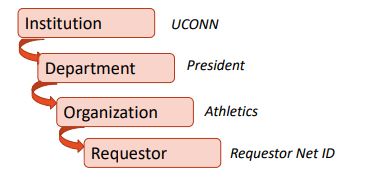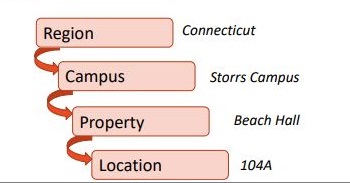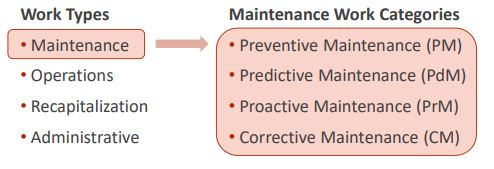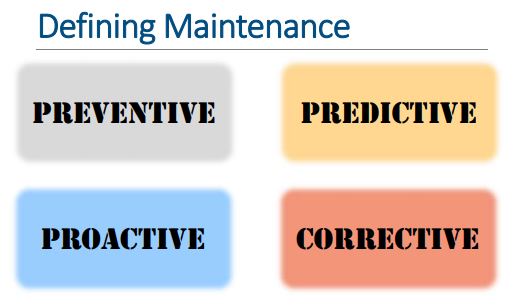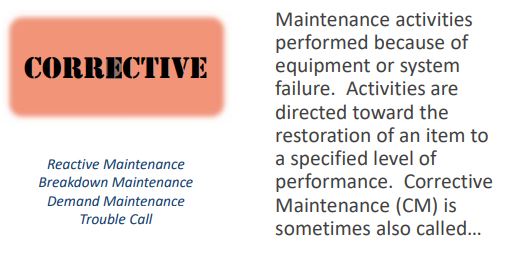Core Concepts and Data Standards
Core Concepts:
• Classify Types of Maintenance
• Prioritize Work
• Evaluate Statuses
• Link to Assets
UConn has developed data standards for input fields in AiM related to Work Management and Asset Management. These standards define the configuration of data for the contact person, location of work, impacted assets, and type of work for maintenance tasks to help you select a value from a provided list, rather than free text fields.
Why use data standards?
• Provide Guidance on Naming Conventions
• Increase Quality of Data
• Optimize System Performance
• Enables Better Reporting
The use of standard lists discourages unnecessary variation in the data that occurs when free text fields are used. Having a defined list of options for input fields allows queries to run successfully and ultimately generate meaningful reports.
Work Management Data Standards – List of Standard Data Fields in AiM:
| Contact Information | Organization and Requestor |
| Location Information | Region, Campus and Property |
| Work Management | Work Type, Work Category, Work Oder Status, Work Phase Status, Phase Priority, Problem Code, Action Taken Code |
| Asset Management | Asset Classification, Asset Type, Asset Groups, Asset Status, Asset Failure Code, Manufactures, Unit of Measure |
Contact and Location Standards:
AiM allows users to track the contact information of personnel entering work requests in case more information or follow-up is required. The location fields allow users to track the area where the work being requested is located for efficiency in resource planning.
These fields are found in screens under the Work Management module (work orders, purchase request, work scheduler, etc.)
Contact and Location Standards – Requestor Hierarchy:
The organizational hierarchy setup determines who is requesting the work and is based on the organizational structure of UConn. The institution code is first set up, which has departments associated to it. Organizations are then associated to departments and finally requestors are associated to organizations. UConn has set up the fields as follows:
The Requestor field is used to document the contact information of the personnel requesting the work.
| Institution | The University of Connecticut is the Institution in each scenario. |
| Department | The Departments are divided into the groups of President, Provost Academic Affairs, Exec VP Admin, and CFO. |
| Organization | The Organizations are divided into groups under each of the Departments (i.e. Athletics, Academic. Affairs, Accounting). |
| Requestor | The Requestor options are linked to the Organization selected and are shown by NetID. |
The example below shows the hierarchy for a contact from the Athletics group:
Contact and Location Standards – Property Hierarchy:
The property hierarchy setup determines where the work is being done. The region code is first set up and then facilities are associated to regions. Properties are then associated to facilities and finally locations are associated to properties.
The Property field is a required when entering a work order to document the area where the work is requested.
UConn has set up the fields as follows:
| Region | Connecticut is the Region in each scenario |
| Campus | The Facility standards are divided by Campus (Storrs, Hartford, Stamford, etc.) |
| Property | The Property options are divided into buildings or areas under each Campus (i.e. Storrs Hall, Hawley Armory, Softball Dugout). |
| Location | The Location information is identified in each Phase and is linked to the Property selected for the parent work order. The locations are listed by room number (100, 100A, 110B). |
The example below shows the hierarchy for work located in Beach Hall.
Classifying Type of Maintenance
The work classification (work types) and category codes are important to organize the data in the IWMS to enable consistent reporting of metrics. The work types and category
codes provide a complete and organized accounting of work performed; as long as it is recorded and entered into the IWMS.
Work Classification Standards – Hierarchy
The work classification hierarchy setup determines what kind of work is to be completed. This classification is based on an organization’s business processes. Types of work (e.g.,
maintenance, construction, administrative, etc.) are first defined and then categories are associated to those types (e.g., within the maintenance type, categories could include
preventive, deferred, service/demand, grounds, contract work, etc.). The work is defined further by associating work order statuses, phase statuses, and work codes to the categories. This classification enables the flexibility to map to any business process.
| Work Type | Maintenance |
| Work Category | Corrective |
| Problem Code | Leak/Flood Problem (and failure cause code if applicable) |
| Action Taken | HVAC Equipment Leak Repair |
Work Classification Standards – Work Type
The different Work Types within AiM include the following:
• Maintenance – includes preventive, predictive, proactive, and corrective maintenance tasks
• Operations – includes access control, custodial services, event support, grounds services, moves, room setups, security, and waste management
• Recapitalization – includes energy conservation, estimating, fixed rate improvements, alterations, programmatic upgrades, renewal and replacement projects
• Administrative – includes improvement projects, leave time, shop time, and training hours for designated tasks
The different types of Maintenance Work Codes including the following:
Benefits of categorizing: Reporting abilities, accurate analysis, resource allocation, and telling your story.
1. Preventive Maintenance (PM): Preventive Maintenance includes planned actions undertaken to retain an item at a specified level of performance by providing repetitive scheduled tasks that prolong system operation and useful life:. This can include inspections, cleaning, lubrication, and part replacement.
2. Predictive Maintenance (PdM): Predictive maintenance (PdM) is maintenance performed when empirical data that is collected and reviewed indicate that maintenance is required. Predictive Testing & Inspection (PT&I) is another term often used interchangeably to more clearly describe PdM processes. PT&I includes nondestructive and non-intrusive methods of investigation and analysis.
3. Proactive Maintenance (PrM): Proactive maintenance is the sum of all maintenance work that is completed to avoid failures.
4. Corrective Maintenance (CM): Maintenance activities performed because of equipment or system failure. Activities are directed toward the restoration of an item to a specified level of performance. Corrective maintenance is also referred to as demand maintenance, reactive maintenance, breakdown maintenance, etc.
Defining Maintenance:
Why must we not only categorize maintenance, but be consistent about it?
Categorizing work accurately brings data for reporting, analysis, resource allocation decisions and also the ability to tell your story. Have you ever been asked if you have enough people to complete your work? A labor needs analysis using information generated from an IWMS can help you answer that question. Analyzing data that categorizes the maintenance types correctly can help identify potential challenges and opportunities to determine the mix that works successfully for UConn.
Things will break, fail, and/or deteriorate to the point where they do not perform their function to a specific standard. No one can prevent ALL failures, nor should they try. There is a
place for corrective maintenance and run-to-failure philosophies.
This type of work is typically addressed as service calls. When equipment is broken or failed and it was reported in need of repair or replacement, the work required is corrective.
